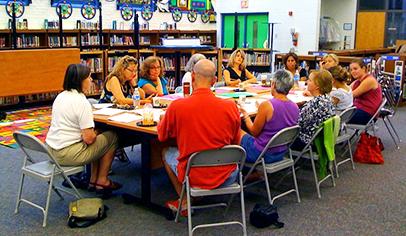The technical differences between a PTA and a PTO are fairly simple. The National PTA is a formal membership organization now headquartered in Alexandria, Va., with a 120-year history of working for children. School-based groups that choose to belong to the PTA must pay dues to the state and national organizations and abide by state and national group rules. In return, they get member benefits, and they get a voice in the operations of the larger organization. The National PTA maintains a Washington, D.C., office where it pursues a public policy agenda, and most state PTA units advocate at their respective state capitals, as well. The PTA carefully protects its name so that only dues-paying members of the group can call themselves a PTA.
PTO, on the other hand, is a generic term that stands for “parent-teacher organization.” It usually represents groups that choose to remain independent. These are most often single-school or district-level groups that operate under their own bylaws and by and large concern themselves with the goings-on at their building or in their town only. Popular acronym include PCC (parent communication council), PTG (parent teacher group), and HSA (home and school association); because PTO is the most common name, we use it generically to refer to all non-PTA school parent groups.
For some groups, the PTO vs. PTA debate is simply a matter of dollars and cents—“We don’t want to send any money out of our school.” For others, the question takes on a significantly increased importance. If we don’t speak for all children, then who will? the PTA’s loyal defenders often ask. Put another way: Do we want to be part of something larger and spend our group dollars outside of our school? Or do we want to focus exclusively on improving and creating community at our school? Since the PTA was the only formal national school parent group, the decision in the past was often “PTA” or nothing.
The PTA, Then and Now
Since its inception in 1897, when Alice McLellan Birney and Phoebe Apperson Hearst started the National Congress of Mothers, the National PTA has spoken out on issues related to child welfare. PTA support played a role in instituting school lunch and inoculation programs. Today, the PTA’s D.C. office is actively involved in working against school vouchers and for increased federal education funding, among other initiatives.
At a more basic level, the group provides a host of resources to affiliated groups that want to take advantage. From a carefully crafted arts campaign to state and national resource manuals (virtual how-to books on running a parent group), PTA member groups are offered many benefits in exchange for group dues.
After 120 years, the PTA name has certainly achieved a high degree of recognition. For the vast majority of Americans, the term “school parent group” goes hand in hand with the term “PTA,” and it’s most often “PTO” that is met with quizzical stares. When Tom T. Hall wrote his chart-topping song, it was “Harper Valley PTA.” The movie and TV series of the same name cemented the impression further. Like Kleenex and Band-Aid, the PTA name is often applied universally. And because PTA is the only national school-parent membership organization, PTA representatives are often used as spokespeople for parents in education debates.
The struggle for the National PTA is not evident in its political activity or its name recognition. Instead, the challenge is at the local level, where some groups struggle to justify the rising expense and the focus on political advocacy against the practical benefits they gain by belonging to the PTA. From a record high of 12.1 million members in 1962, PTA membership dropped to just over 5 million in the early 1980s and today stands at close to 4 million. There are PTA units in 27 percent of public and private K-8 schools in the United States, based on figures from the National Center for Education Statistics and information from National PTA reports. While there is no highly accurate count of PTO groups (because independent PTOs do not report to one central organization), a conservative estimate—based on PTO Today’s communication with tens of thousands of school parent groups—puts the number of independent PTO groups at more than double that of PTA units.
On the financial side of the discussion, the average local PTA forwards an estimated $550 to its state and national organizations in dues alone; sometimes county dues are added, as well. Increasingly, groups are looking at those dollars in terms of what the money could do for the local school—pay for a field trip, perhaps, or provide new technology for classrooms. Some groups would prefer to charge no dues, instead considering all parents automatic members of the parent group at their child’s school. When measured in purely economic terms of costs versus benefits, local groups often ask, “Are we getting enough value for the hundreds of dollars we pay in dues?”
That calculation becomes more difficult as PTA dues increase. National PTA per-member dues are currently $2.25 per member; states (and sometimes PTA county councils) charge additional per-member dues ranging from a couple of dollars all the way up to $12 or more per member in Oregon.
“I converted three PTA groups to PTOs many years ago,” a New Jersey parent group leader posted in the PTO Today message boards in 2014. “We desperately needed (and still need) to keep as many dollars in our schools to support vital programs for our students.”
In the past 10 to 20 years, the National PTA has also increasingly emphasized its political advocacy agenda and its role as a voice for all children. Creating a new leadership structure—through a reshuffling of its board, the creation of a highly paid CEO position for the group, and a broad expansion of headquarters staff and payroll—was a move aimed at repositioning the PTA as an important player with a voice in national issues.
The public debate over what the PTA voice should say has at times been heated. While the PTA says that its political role is central to its mission and has been for more than a century, local units may not see the value. The PTA takes strong public stands on some controversial issues; most PTA policy stances are voted on at the group’s annual convention each June. Typically, 1,000 to 2,000 PTA members—from about 3.8 million members nationwide—are certified to vote at that convention. Because local member units must make a commitment to publicly support all National PTA positions, in some cases groups have disassociated from the PTA rather than do so.
PTOs Are No Longer Alone
The Internet has played a part in the changing role of the National PTA, as well. Not long ago, the PTA could rightfully claim to be the only provider of parent group resources. If you wanted information on running a group or fundraising or Robert’s Rules of Order, or if you wanted materials on Attention-Deficit/Hyperactivity Disorder or school bus safety or bullying, the PTA was a valued clearinghouse. Today, with the advent of round-the-clock communication and the spread of online access, that role of the PTA is less pressing. There are dozens of websites focused specifically on parent involvement, fundraising, or playgrounds, as well as any parenting or child development topic you might want to learn about.
Even one of the National PTA’s most common selling points—that local PTAs have access to training, networking opportunities, organizational resources and more (and therefore non-PTAs don’t)—is far less true today. Since the establishment in 1999 of PTO Today, which focuses on providing resources and services to parent-teacher groups, all parent groups now have access to many of the services once available only to PTAs. With a print magazine, an active online community, a series of vendor and networking fairs across the country, and a host of programs and tools designed specifically to help PTO and PTA leaders, PTO Today is a valuable resource for all parent groups.
Much as PTA officials are often looked to by national media for input on parent and parent involvement issues, PTO Today has assumed a similar role. PTO Today experts and PTO Today content have appeared on national and local television and radio and in newspapers across the country, including USA Today, Newsweek, the New York Times, the Los Angeles Times, the Boston Globe, Child magazine, and Martha Stewart Kids. Similarly, PTO Today’s partnerships with consumer companies like Trend Micro, LeapFrog, Lowe’s Home Improvement, and others have made additional resources available for free to all PTOs and PTAs.
The vast majority of PTO Today’s services are used by both PTOs and PTAs alike. At one time, it was thought that groups leaving the PTA desired isolation, but the strong grassroots response to PTO Today’s offerings suggests that perhaps those groups were simply looking for a different model of assistance. Where once the only practical way for a parent group to get liability insurance or to attend a parent group event was to affiliate with the PTA, now PTO Today offers more cafeteria-style access to insurance, trade shows, and more. Groups can now compare the costs and benefits of PTA affiliation to the costs and benefits of remaining independent and make their own eyes-open decision on which model works best for them.
Despite talk of differences and division, two important facts remain. First, nearly all K-8 schools still have active parent groups, and second, nearly all active parent groups work toward the same goal: to foster strong, nurturing schools. Even PTA-affiliated parent groups, which are part of the larger “all children” philosophy, spend the majority of their time working within their local school community.
The simple truth is that PTOs and PTAs are more alike than they are different. Put 1,000 PTA members in a room with 1,000 PTOers and you wouldn’t be able to tell them apart. Committed, generous volunteers are the common denominator. Whether it’s through a PTA, a PTO, or another mechanism, as long as those volunteers continue to support their schools, then children—all children—will be the winners.
National PTA® is a trademark of the National Congress of Parents and Teachers and is not affiliated with PTO Today®.
Originally posted in 2009 and updated regularly.















